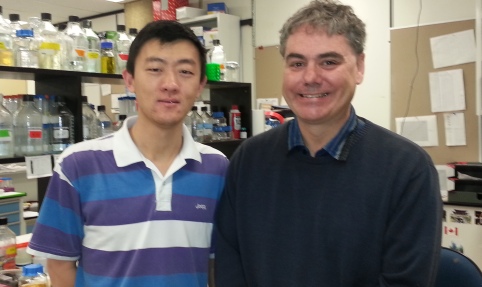
A new discovery linking complex multicellular organisms, like humans, to basic organisms including yeast and bacteria, may be a stepping stone to understanding a range of human illnesses.
New research from the laboratory of Andrew MacMillan at the Faculty of Medicine & Dentistry has identified a switch-like mechanism in the spliceosome, a complex found in the nucleus of a human cell that controls the biological process called splicing. This ancient process, conserved over a billion years of evolution from yeast to humans, is how non-coding bits and coding bits of RNA express the genetic code. Mistakes in the splicing process are estimated to cause roughly 40 per cent of human genetic diseases.
MacMillan's research focused on the heart of the spliceosome, which includes two RNA molecules and a protein called PRP8.
"This is a very ancient structure that is preserved through all life forms. It's a protein domain that's found all the way back to the simplest bacteria," MacMillan said of the section of the spliceosome that his team studied.
Using X-ray techniques, genetics and biochemistry, an extension of the protein has shown evidence of movement, acting like a toggle or switch to regulate the removal of coding and non-coding bits of RNA.
"This work reveals a fundamental regulatory mechanism for the expression of our genes but also shows a link between very ancient and modern higher forms of life. It has implications for the origin and evolution of catalytic activity in cells," said MacMillan who works in the Department of Biochemistry.
Early studies of gene expression suggested a biological chicken-and-egg paradox in the relationship between DNA, RNA and protein. The information in DNA is transmitted through RNA, which directs the synthesis of proteins to express the genetic code. But DNA and RNA are synthesized themselves by proteins. The "RNA World" idea began to develop to address this paradox, theorizing that a primeval RNA molecule carrying genetic information could replicate itself, and eventually evolved into cells where proteins took over most catalytic activity.
"RNA splicing has long been thought of as a fossil of the RNA World where the RNA parts of the spliceosome are responsible for the splicing reactions. What this work suggests is that actually there's a protein at the heart of the splicing machinery that also participates. The RNAs are critical, but we believe the PRP8 protein also participates. So one way to look at this is that this is a system that evolved from a very ancient organism and is a bridge between the world where RNAs did things to the world in which proteins do things."
This article is featured on the front cover of the June issue of Nature Structural & Molecular Biology and was featured in June 2013 Nature News and Views.